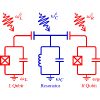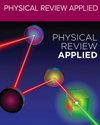驱动谐振器辅助超导量子比特的快速无 ZZ 纠缠门
IF 4.4
2区 物理与天体物理
Q2 PHYSICS, APPLIED
引用次数: 0
摘要
设计高保真双量子比特门是实现实用量子计算不可或缺的一步。对于超导量子平台来说,一个重要的问题是量子比特之间的杂散相互作用,这会导致严重的相干误差。对于跨门量子比特,减轻这种误差的协议通常涉及微调硬件参数或引入通常有噪声的通量可调耦合器。在这项工作中,我们提出了一种消除这些杂散相互作用的简单方案。用于消除杂散相互作用的耦合器是一个驱动型高相干谐振器,驱动的振幅和频率可作为控制旋钮。通过谐振器引起的相位相互作用,静态 ZZ 耦合可以被完全中和。我们从数值上证明,这种方案可以实现短时间内的高保真纠缠门,包括 40 ns 内的交叉共振受控-非(cnot)门和 140 ns 内的绝热受控-Z 门。我们的架构不仅不含 ZZ,而且不包含额外的噪声成分,因此它能保留固定频率跨mon质子的相干时间。利用最先进的相干时间,我们的交叉共振 cnot 门的误差可降至 10-4 以下。本文章由计算机程序翻译,如有差异,请以英文原文为准。

Fast ZZ-free entangling gates for superconducting qubits assisted by a driven resonator
Engineering high-fidelity two-qubit gates is an indispensable step toward practical quantum computing. For superconducting quantum platforms, one important setback is the stray interaction between qubits, which causes significant coherent errors. For transmon qubits, protocols for mitigating such errors usually involve fine-tuning the hardware parameters or introducing usually noisy flux-tunable couplers. In this work, we propose a simple scheme to cancel these stray interactions. The coupler used for such cancelation is a driven high-coherence resonator, where the amplitude and frequency of the drive serve as control knobs. Through the resonator-induced-phase interaction, the static coupling can be entirely neutralized. We numerically show that such a scheme can enable short and high-fidelity entangling gates, including cross-resonance controlled-not (cnot) gates within 40 ns and adiabatic controlled- gates within 140 ns. Our architecture is not only -free, but also contains no extra noisy components, such that it preserves the coherence times of fixed-frequency transmon qubits. With the state-of-the-art coherence times, the error of our cross-resonance cnot gate can be reduced to below .
求助全文
通过发布文献求助,成功后即可免费获取论文全文。
去求助
来源期刊

Physical Review Applied
PHYSICS, APPLIED-
CiteScore
7.80
自引率
8.70%
发文量
760
审稿时长
2.5 months
期刊介绍:
Physical Review Applied (PRApplied) publishes high-quality papers that bridge the gap between engineering and physics, and between current and future technologies. PRApplied welcomes papers from both the engineering and physics communities, in academia and industry.
PRApplied focuses on topics including:
Biophysics, bioelectronics, and biomedical engineering,
Device physics,
Electronics,
Technology to harvest, store, and transmit energy, focusing on renewable energy technologies,
Geophysics and space science,
Industrial physics,
Magnetism and spintronics,
Metamaterials,
Microfluidics,
Nonlinear dynamics and pattern formation in natural or manufactured systems,
Nanoscience and nanotechnology,
Optics, optoelectronics, photonics, and photonic devices,
Quantum information processing, both algorithms and hardware,
Soft matter physics, including granular and complex fluids and active matter.
 求助内容:
求助内容: 应助结果提醒方式:
应助结果提醒方式:


